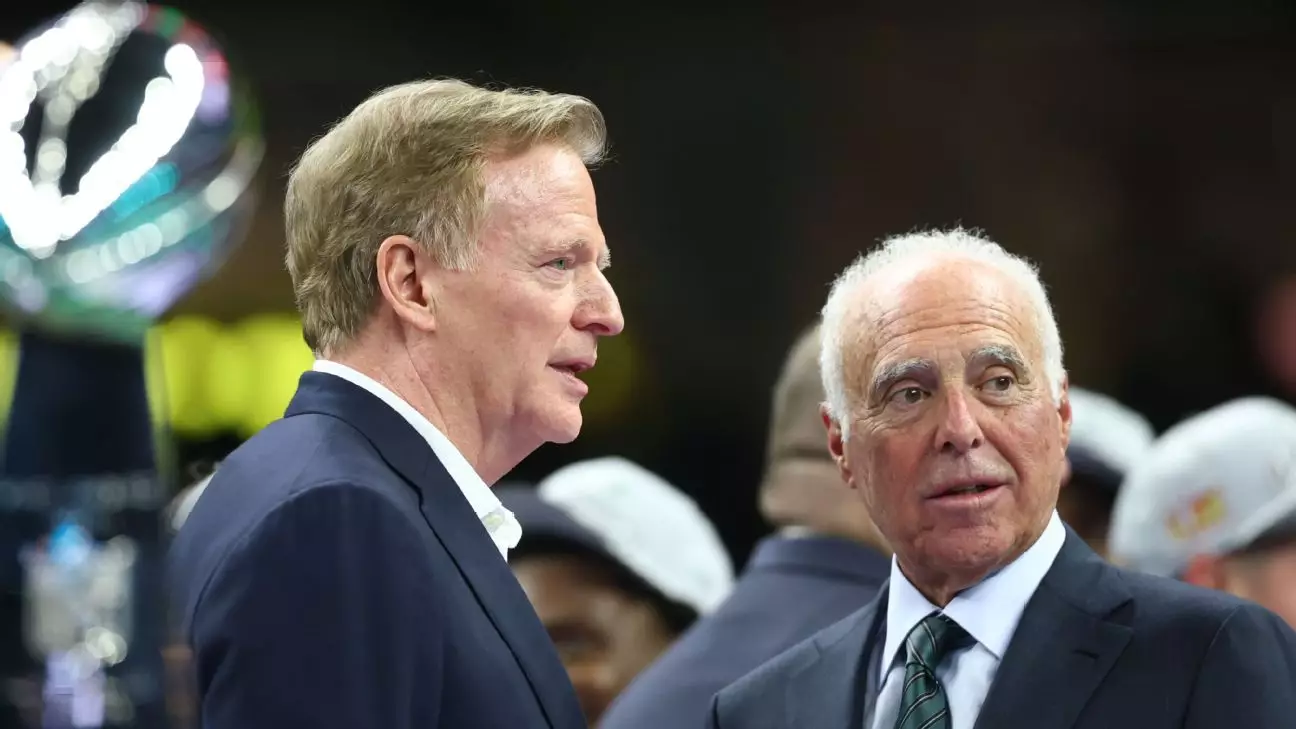In the latest round of drama within the NFL, the debate surrounding the controversial “tush push” play has ignited passionate exchanges among franchise owners and league executives. This highly charged discussion, held during a general session in Eagan, Minnesota, exposed deeper rifts and contrasting ideologies on the future of gameplay, player safety, and the very fabric of what makes football, well, football. The emotional turmoil came to the forefront, revealing not just opinions about a single play, but a struggle over the principles dictating the game itself.
Eagles owner Jeffrey Lurie delivered a bold rebuttal to those advocating for the ban, emphasizing the cultural impact of an innovation that has sparked both admiration and ire across the league. This ongoing tug-of-war raises an essential question: is the NFL willing to embrace change, or are they shackling themselves to outdated traditions? Lurie’s impassioned plea prompted eye rolls from some and cheers from others, showcasing the divide between those who yearn for innovation and those who cling to convention.
The Tush Push: A Double-Edged Sword
The “tush push,” a euphemism that encapsulates both strategy and physical prowess, can be seen as a symbol of modern football’s evolution. In one fell swoop, it combines teamwork, timing, and brute force, allowing teams to convert critical short-yardage situations. Lurie’s comparisons articulated in his lengthy speech implied that its effectiveness is both a testament to the Eagles’ ingenuity and an indictment of defensive strategy across the league. This juxtaposition, however, escalates the tensions between offensive creativity and defensive integrity. Lurie’s assertion that banning the play would endanger quarterbacks adds further complexity to an already fraught discussion, one that runs deeper than mere game mechanics.
What is particularly enthralling about this debate is how it encapsulates the central conflict of football itself: the exhilarating rush of competition versus the imperative for player safety. It becomes a microcosm of society’s broader struggles between innovation and tradition, style and substance, glory and risk. The question remains: how does the NFL balance the exhilarating nature of the game with the potential physical ramifications that innovations like the tush push could invite?
The Spectacle of Debate
Lurie’s narrative crescendo not only revealed his commitment to the Eagles’ tactics but also displayed his willingness to confront the league’s brass. By likening the dilemma of potentially banning a successful play to a “wet dream for a teenage boy,” he struck a chord that resonated—whether intended or not—across the room. This comment, however, was not without its fallout; it elicited disdain from some attendees, including NFL executive Troy Vincent, who chastised Lurie for his lack of tact in a mixed-gender environment.
The juxtaposition of Lurie’s raw remarks with the polished professionalism typically expected from league meetings underscores the heightened emotions at play. This situation fervently calls into question whether the NFL is prepared for a more casual admission of passion and authenticity in its discussions or whether it prefers to maintain a reserved demeanor, even amid challenges.
The Aftermath and Future Implications
Interestingly, as the meeting progressed, Lurie was met with both support and skepticism. Dallas Cowboys owner Jerry Jones’s inquiries and Terry Pegula’s practical criticisms reveal a league grappling with a dichotomy: the tactical pitfalls versus potential advantages of the play. The tension culminated in a fascinating observation: the inability to ban the tush push, decided by a mere two votes, exemplifies how divisions remain stirring underneath the surface of what is often portrayed as a monolithic entity.
In the end, the divisive debate over the tush push is emblematic of larger philosophical and operational quandaries within the league. While some see innovation as an enemy to tradition and safety, others view it as an essential driver of progress—the very essence of America’s most beloved sport hinging on its capacity to adapt. In this theater of ideas, the insistence on a ban may merely postpone the inevitable acceptance of the next transformative play, one that could again challenge our perceptions of the game. The NFL has a choice: to stifle innovation for perceived safety or to embrace the inevitable chaos that fuels its legacy. The stage is set, and the future of the game hangs in balance.

Leave a Reply